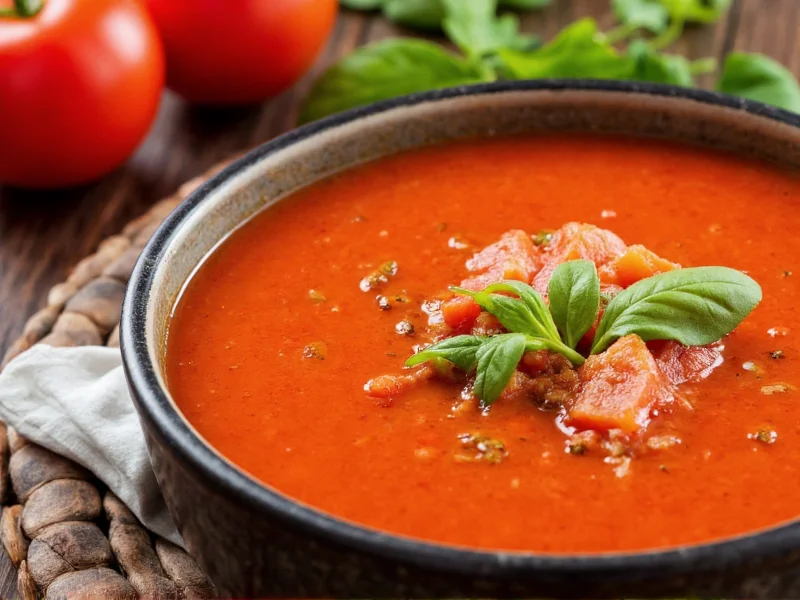Understanding what defines authentic tomato soup helps both home cooks and culinary enthusiasts appreciate this beloved comfort food. While seemingly straightforward, the best tomato soups balance acidity, sweetness, and umami flavors through careful ingredient selection and cooking techniques.
The Essential Components of Quality Tomato Soup
Creating exceptional tomato soup requires attention to several key elements. The foundation starts with quality tomatoes—whether fresh ripe varieties in season or high-quality canned San Marzano tomatoes off-season. The cooking liquid matters significantly; many professional chefs use a combination of vegetable broth and tomato juice for depth of flavor.
Proper seasoning separates adequate tomato soup from outstanding versions. Beyond salt and pepper, successful recipes often incorporate:
- A splash of acidity (like balsamic vinegar) to brighten flavors
- A touch of sweetness (such as a carrot or pinch of sugar) to balance tomato acidity
- Fresh herbs added at the right moment to preserve their flavor
- Aromatics properly sautéed before adding liquids
Popular Tomato Soup Variations Worldwide
While the classic version remains popular, numerous cultural interpretations exist. Spanish sopa de tomate often includes bread for thickness, Italian zuppa di pomodoro might feature pasta or rice, and French soupe à la tomate frequently incorporates cream. For those exploring healthy tomato soup alternatives, roasted tomato versions develop deeper flavors without added fats.
| Tomato Soup Style | Ideal Pairings | Why They Work |
|---|---|---|
| Classic Creamy | Grilled cheese sandwich | Crispy texture contrasts smooth soup; cheese complements tomato acidity |
| Roasted Tomato | Crusty artisan bread | Absorbs soup while adding complementary roasted flavors |
| Gazpacho (chilled) | Seafood tapas | Cold soup refreshes palate between savory seafood bites |
| Spicy Arrabbiata | Garlic bread | Garlic enhances spice while providing cooling contrast |
Nutritional Profile and Health Considerations
When evaluating tomato soup nutritional value, consider that tomatoes provide lycopene, a powerful antioxidant more bioavailable when cooked. A standard serving (1 cup) of homemade tomato soup typically contains:
- Approximately 100-150 calories
- 2-4 grams of dietary fiber
- Significant vitamin C and potassium
- Naturally low in fat (unless cream is added)
For those monitoring sodium intake, preparing low sodium tomato soup at home allows complete control over salt content. Using no-salt-added broth and fresh tomatoes creates a heart-healthy option that still delivers robust flavor.
Perfect Pairings for Tomato Soup
Understanding what goes well with tomato soup elevates it from a simple meal to a complete dining experience. The ideal accompaniments balance the soup's acidity and create textural contrast:
- Cheese-focused pairings: Grilled cheese sandwiches (cheddar or gruyère work particularly well), cheese toasties, or Parmesan crisps
- Bread options: Crusty baguettes, focaccia, or garlic bread for dipping
- Salad companions: Simple green salads with vinaigrette or Caesar salad
- Protein additions: Grilled chicken, shrimp, or white beans for heartier meals
Creating Restaurant-Quality Tomato Soup at Home
Professional chefs achieve depth in classic tomato soup recipe versions through several techniques home cooks can replicate. Roasting tomatoes and aromatics before blending develops complex flavors through caramelization. Adding a small amount of tomato paste that's been cooked until it darkens slightly creates umami richness.
For the smoothest texture without resorting to heavy cream (though that's perfectly acceptable for non-dietary restriction versions), try finishing with a swirl of Greek yogurt or blending in a small cooked potato. These techniques create creamy texture while maintaining the soup's vibrant color and fresh tomato flavor.
Seasonal Considerations for Tomato Soup
The best fresh tomato soup preparation varies by season. During summer's tomato peak, use ripe heirloom varieties for exceptional flavor. In winter months, high-quality canned San Marzano tomatoes often outperform fresh off-season options. Many chefs maintain year-round quality by preserving summer tomatoes through canning or freezing.











 浙公网安备
33010002000092号
浙公网安备
33010002000092号 浙B2-20120091-4
浙B2-20120091-4